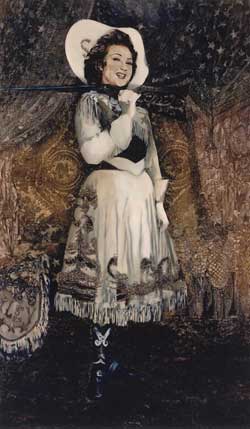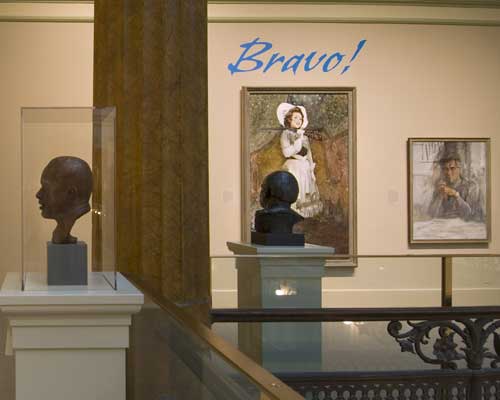Ethel Merman: Queen of the American Musical Stage

Oil and acrylic on canvas / National Portrait Gallery,
Smithsonian Institution; gift of Ethel Merman
This blogpost originally appeared Aug. 14, 2008
In this blog post, Amy Henderson, a historian at the National Portrait Gallery, discusses Ethel Merman, and her 1971 portrait by artist Rosemarie Sloat. The portrait is currently on view at NPG, in the "Bravo!" exhibition, on the museum’s third floor mezzanine.
It was one of the most riveting moments of my life—the day I strolled into my office and found myself face-to-face with Ethel Merman. The Queen of the American Musical Stage was not there to visit me, needless to say, but to pay homage to the larger-than-life portrait that hung on my wall. The portrait was enormous, more than seven feet high, and depicted La Merman outfitted in fringe and toting a gun for one of her best-known roles, as Annie Oakley in Annie Get Your Gun. Dressed this day in a subdued suit and with her hair swirled into a light brown cloud, Merman stood enraptured by the painting.
There were tears in her eyes when she turned to me as I tiptoed into the room, trying not to interrupt—well, actually, I was trying not to jump up and down and scream “Wow!! You’re Ethel Merman!!!” Her voice was soft as she said, “I love this picture.” But it was definitely The Voice.
It was the same voice that had catapulted her to overnight stardom in the Gershwins’ 1930 Broadway musical, Girl Crazy. When she sang “I Got Rhythm” on opening night, she stopped the show: “I held a high C note for sixteen bars while the orchestra played the melodic line—a big, tooty thing—against the note. By the time I’d held that note for four bars the audience was applauding. . . .” They kept applauding, and she did several encores. “When I finished that song,” she recalled, “a star had been born. Me.”
Her vibrant personality and clarion voice reverberated through Broadway’s greatest years, and America’s leading composers adored her. Cole Porter once said, “I’d rather write songs for Ethel Merman than anyone else in the world,” and songwriters from the Gershwins to Stephen Sondheim and Jule Styne agreed. Merman thought it was because she was always true to the lyrics—“I sing honest. Loud, but honest.”
Irving Berlin’s Annie Get Your Gun was a defining role for her, providing the anthem that became her signature song, “There’s No Business Like Show Business.” Opening at the Imperial Theatre on May 16, 1946, Annie Get Your Gun ran for 1,147 performances. Twenty years after Annie’s premiere, Merman starred in a highly successful revival at Lincoln Center. She became so closely identified with the role that when her portrait was painted for a 1971 Gallery exhibition, “Portraits of the American Stage,” she chose to be depicted as Annie Oakley.
Artist Rosemarie Sloat was selected to paint her, and she began by sketching Merman in her dressing room at the St. James Theatre after a matinee performance of Hello, Dolly! Sloat reported that she was extremely cooperative—“She’s a warm, wonderful woman and she talks constantly.”
For the portrait, Sloat used her palette knife to layer stars, spangles, and fringe with hills and valleys of paint. And to create the filigreed curtains and embroidery effect for the Annie costume, she squeezed swirls and gobs of acrylic directly from tube onto canvas. The three-dimensional metallic texture showcases the brassy Merman stage personality—so much so that Merman suggested the portrait be used as the cover illustration for the Annie Get Your Gun cast recording.
Indeed, Ethel Merman was so fond of this portrait that when she heard that a search was on for a donor, she bought it herself and presented it to the National Portrait Gallery. It is the only life portrait of Ethel Merman ever done.
